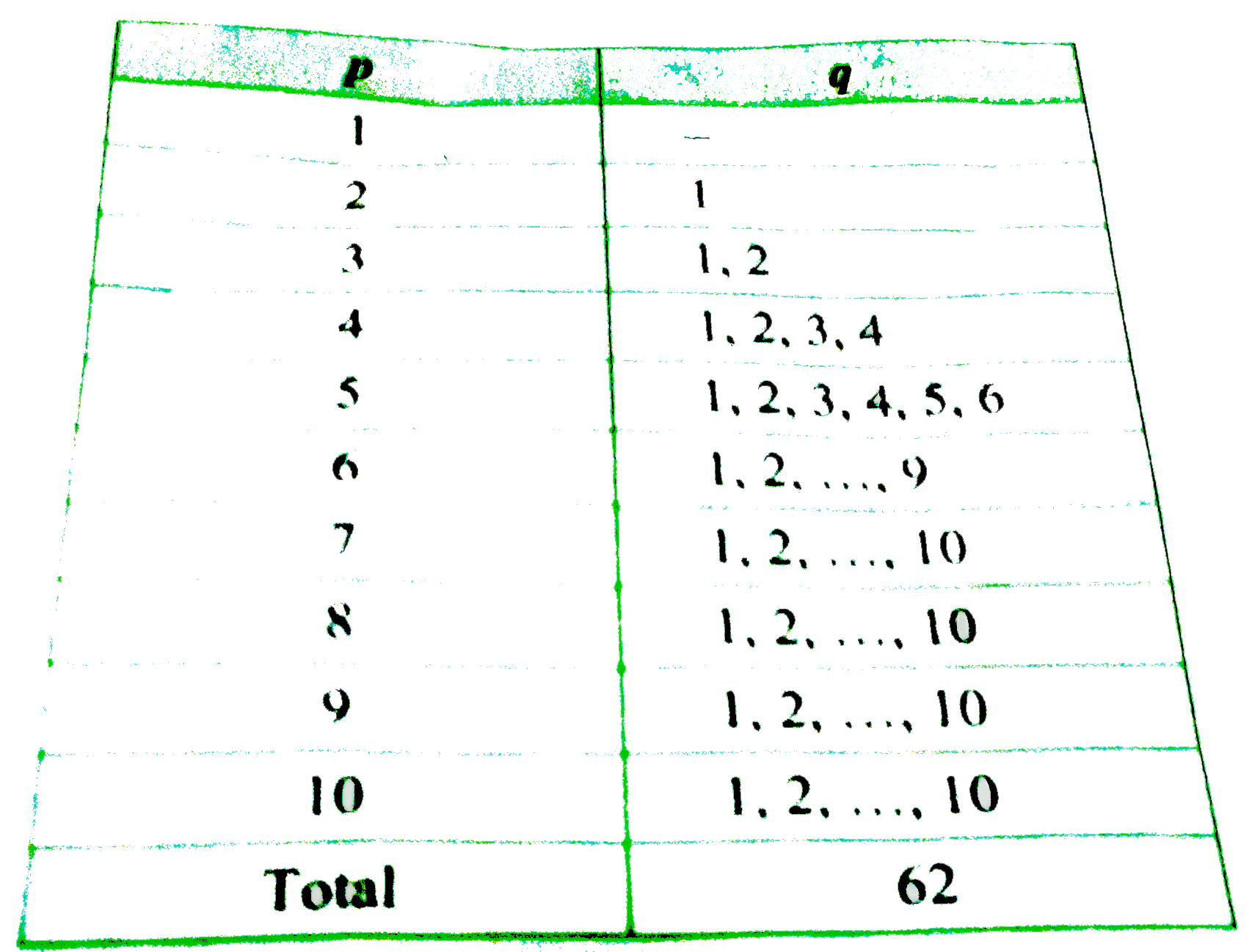If pandq are chosen randomly from the set {1,2,3,4,5,6,7,8,9,10} with replacement, determine the probability that the roots of the equation x2+px+q=0 are real.Solution in Bengali
are real is 33/50
are imaginary is 19/50
are real and equal is 3/50
are real and distinct is 3/5
The correct Answer is:B, C, D
Roots of x2+px+q=0 will be real if p2≥ 4q. The possible selection are as follows:

Therefore, number of favourable ways is 62 and total number of ways is 102=100. Hence, the required probaility is
62/100=31/50.
The probability that the roots are imaginary is
1−31/50=19/50.
Roots are equal when (p, q) = (2, 1), (4, 4), (6, 9). The probability that the roots are real and equal is 3/50. Hence, probability that the roots are real and distinct is 3/5.
Topper's Solved these Questions
- BOOK - CENGAGE PUBLICATIONCHAPTER - PROBABILITY I EXERCISE - Comprehension14videos
PROBABILITY I
- BOOK - CENGAGE PUBLICATIONCHAPTER - PROBABILITY I EXERCISE - Match2videos
PROBABILITY I
- BOOK - CENGAGE PUBLICATIONCHAPTER - PROBABILITY I EXERCISE - Exercise 9.37videos
PROBABILITY I
- BOOK - CENGAGE PUBLICATIONCHAPTER - PROBABILITYEXERCISE - All Questions470videos
PROBABILITY
- BOOK - CENGAGE PUBLICATIONCHAPTER - PROBABILITY IIEXERCISE - MULTIPLE CORRECT ANSWER TYPE6videos
PROBABILITY II
Similar Questions
A shopping mall is running a scheme: Each packet of detergent SURF contains a coupon which bears letter of the word SURF, if a person buys at least four packets of detergent SURF, and produce all the letters of the word SURF, then he gets one free packet of detergent.
If a person buys 8 such packets, then the probability that he gets two free packets is06:05View Solutionn whole are randomly chosen and multiplied
Column I, Column II
The probability that the last digit is 1,3,7, or 9 is, p. 8n−4n10n
The probability that the last digit is 2,4,6, or 8 is, q. 5n−4n10n
The probability that the last digit is 5 is, r. 4n10n
The probability that the last digit is zero is, s. 10n−8n−5n+4n10nView SolutionAandB are two candidates seeking admission in IIT. The probability that A is selected is 0.5 and the probability that AandB are selected is at most 0.3. Is it possible that the probability of B getting selected is 0.9?
View SolutionA coin is tossed three times, consider the following events. A : ‘No head appears’, B: ‘Exactly one head appears’ and C: ‘Atleast two appear’. Do they form a set of mutually exclusive and exhaustive events?
03:39View SolutionLet EandF be two independent events. The probability that exactly one of them occurs is 1125 and the probability if none of them occurring is 225. If P(T) denotes the probability of occurrence of the event T, then (a) P(E)=45,P(F)=35 (b) P(E)=15,P(F)=25 (c) P(E)=25,P(F)=15 (d) P(E)=35,P(F)=45
View SolutionIf pandq are chosen randomly from the set {1,2,3,4,5,6,7,8,9,10} with replacement, determine the probability that the roots of the equation x2+px+q=0 are real.
05:57View SolutionIf p and q are chosen randomly from the set {1, 2, 3, ………, 10} with replacement, then the probability that the roots of the equation x2+px+q=0 are real is
View SolutionIf a and b are chosen randomly from the set {1,2,3,4} with replacement, then the probability of the real roots of the equation x2+ax+b=0 is
03:58View SolutionIf a and b are chosen randomly from the set {1,2,3,4} with replacement, then the probability of the real roots of the equation x2+ax+b=0 is:
03:23View SolutionIf a and b are chosen randomly from the set {2,3,4,5} with replacement, then the probability of the real roots of the equation x2+ax+b=0 is:
11:00View SolutionIf a and b are chosen randomly from the set {1,2,3,4} with replacement, then the probability of the real roots of the equation x2+ax+b=0 is
09:58View SolutionIf p and q are chosen from the set (1, 2, 3, 4, 5, 6, 7, 8, 9, 10), with replacement, the probability that the roots of the equation x2+2px+q=0 are real is
04:26View SolutionIf pandq are chosen randomly from the set {1,2,3,4,5,6,7,8,9,10} with replacement, determine the probability that the roots of the equation x2+px+q=0 are real.
06:04View SolutionIf pandq are chosen randomly from the set {1,2,3,4,5,6,7,8,9,10} with replacement, determine the probability that the roots of the equation x2+px+q=0 are real.
04:48View SolutionIf p and q are chosen randomly from the set {1, 2, 3, 4, 5, 6, 7, 8, 9, 10} with replacement. Find the probability that the roots of the equation x2+px+q=0 are real.
06:54View SolutionIf p and q are chosen randomly from the set {1, 2, 3, 4, 5} with replacement. Find the probability that the roots of the equation x2+px+q=0 are equal.
08:01View Solution

